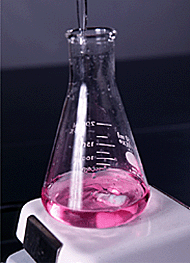|
Titration - determining the strength of an unknown base The determination of a base is carried out by titration of the unknown solution using a standard acid solution. The bench sodium hydroxide is a solution of approximately 1 mol dm-3. The purpose of this experiment is to determine its exact molarity. It is to be determined by reaction with a potassium hydrogenphthalate primary standard solution. Note: Titrations work better with solution concentrations of between 0.01 and 0.2 mol dm-3. The bench sodium hydroxide cannot be titrated directly. |
 |
Standard solutions
Potassium hydrogenphthalate is a primary standard, having the following characteristics
- It is a crystalline solid available in pure form
- It is stable in the environment
- It has a high relative mass
These characteristics allow the preparation of a standard solution to a good degree of accuracy.
Part 1 - preparing the standard solution
Accurately weigh out approximately 5.2 g of potassium hydrogenphthalate (Mr = 203.23)
Transfer to a volumetric flask and dissolve in about 100 ml of distilled (deionised) water. Then make up to the mark with distilled (deionised) water.
Invert several times to ensure complete mixing.
Part 2 - preparing the sodium hydroxide solution
Transfer a 25 ml aliquot of the 'bench' sodium hydroxide solution into a 250 ml volumetric flask using a pipette and filler.
Add distilled (deionised) water to the mark.
Invert several times to ensure complete mixing.
Part 3 - the titration
Transfer a 25ml aliquot of the potassium hydrogenphthalate solution into a conical flask using a pipette and filler.
Add 5 drops of phenolphthalein indicator solution
Fill a 50 ml burette to the 0.00 mark with the diluted sodium hydroxide solution.
Add the sodium hydroxide slowly to the acid/indicator solution in the conical flask swirling constantly until the first permanent hint of pink appears (the end-point).
Repeat the steps above, adding the sodium hydroxide dropwise near the end-point.
Repeat the titration as many times as needed to obtain concordant results (results within 0.1 ml of each other)
Ensure that all of the data is recorded with suitable units and inaccuracies.
The following shows example raw data and analysis.
Raw data
Mass of potassium hydrogenphthalate = 5.22g ± 0.01
The initial solutions are all colourless.
| Titre | Initial burette reading /ml ± 0.05 | Final burette reading /ml ± 0.05 | Volume added /ml ± 0.1 | Observations |
| 1 | 0.00 | 25.25 | 25.25 | red end |
| 2 | 0.05 | 24.85 | 24.80 | pink end |
| 3 | 0.00 | 24.75 | 24.75 | pale pink |
Data analysis
Titres 2 & 3 are concordant and were used to average the titration volume = (24.80 + 24.75)/2= 24.775
This is rounded to three sigificant figures as the inaccuracy is ± 0.1
Hence titre = 24.8 ml ± 0.1
The moles of potassium hydrogenphthalate used = mass/Mr = 5.22/203.23 = 0.00257
Molarity of the potassium hydrogenphthalate solution used = 0.00257/0.25 = 0.103 mol dm-3
Moles of potassium hydrogenphthalate in 25 ml aliquot = 0.103 x 0.025 = 2.57 x 10-3
Equation for the reaction between sodium hydroxide and potassium hydrogenphthalate (abbreviated to KHPh):
NaOH + KHPh → KNaPh + H2O
Hence moles of sodium hydroxide also = 2.57 x 10-3
Volume of sodium hydroxide from the titration = 24.8 ml

Hence molarity of sodium hydroxide = 0.104
The was diluted in a ratio of 1:10 from the original stock bottle
Hence concentration of sodium hydroxide in the original stock bottle = 1.04 mol dm-3
Treatment of errors and inaccuracies
These should be recorded as percentage inaccuracy and then propagated through a typical series of steps:
1 Making the potassium hydrogenphthalate solution:
Mass of potassium hydrogenphthalate = 5.22g ± 0.01 = 0.19% (inaccuracy)
Volumetric flask 250 ml ± 0.23 = 0.092%
2 Transfering 25 ml aliquot (pipette)
25 ml ± 0.06 = 0.24%
3 Titration inaccuracy
24.8 ml ± 0.1 = 0.40%
Total inaccuracy = 0.19 + 0.09 + 0.24 + 0.40 = 0.92%
Applying this inaccuracy to the sodium hydroxide give molarity = 1.04 ± 0.01
